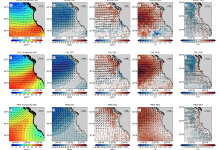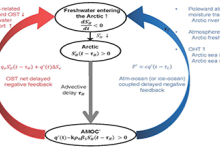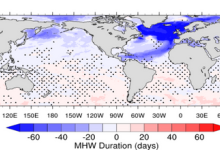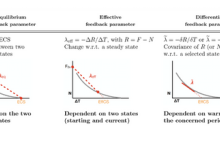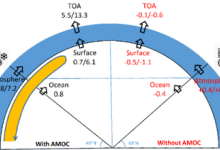Research Highlights
We aim to feature the latest research results from US scientists whose published paper features work that is sponsored by one or more sponsoring agency programs of US CLIVAR (NASA, NOAA, NSF, DOE, ONR). Check out the collection of research highlights below and sort by topic on the right. Interested in submitting an article for consideration? See our Research Highlight Submission Guidelines page for more information.
This study focuses on Northeast Pacific ARs and their impact on the upper ocean. Understanding upper ocean impacts requires high fidelity to properly resolve the processes at play. Coupling an eddy-resolving ocean model to a 25km grid-spacing high-resolution atmosphere allows resolution of both ARs and ocean processes regionally and with greater accuracy.
The mechanisms of multidecadal AMOC variability and its two-way interactions with the Arctic salinity anomaly, as well as the factors affecting the periods and amplitudes of multidecadal AMOC variability are not well understood from the theoretical perspective using simple conceptual models. In a recent study authored by Wei and Zhang, a simple conceptual model (i.e. a revised Stommel’s Two-Box Model) calibrated by the OSNAP observations, is constructed to illustrate the AMOC delayed oscillator mechanism and suggests an important role of the Arctic salinity anomaly and associated delayed negative feedback in multidecadal AMOC variability.
Marine heatwaves (MHWs) feature prolonged extreme warm events in global oceans that have dramatic impacts on marine ecosystems and fisheries. In a recent paper published in Geophysical Research Letters, Ren and Liu proposed a new physical driver — the Atlantic Meridional Overturning Circulation (AMOC) and its related slowdown — can modulate global MHWs through centuries. The results from this study highlight the importance of the AMOC as a key ocean circulation system and to the long-term variations of climate extremes such as MHWs. Moreover, the AMOC impact is of a global scale and becomes increasingly significant.
Recent and ongoing research shows that atmospheric radiative feedbacks depend on changes in sea-surface temperature patterns (“pattern effect”) and global mean temperature (“feedback temperature dependence”). This implies that feedbacks can change as warming patterns and global temperature evolve over time, counter to what has been assumed for decades. This realization has led to a proliferation of feedback definitions and methods to estimate equilibrium climate sensitivity (ECS). In a recent Geophysics Research Letters paper, Rugenstein and Armour contrast the equilibrium, effective, and differential feedback parameter definitions and discuss their physical interpretations and applications. Importantly, these feedback definitions imply different values of effective or equilibrium climate sensitivity.
Densely populated regions located at the mid-latitude Northern Hemisphere have been hit by extreme winter weather in recent years. In a recent paper by Yin and Zhao, the authors use a state-of-the-art global weather/climate modeling system with high resolution to better understand the role of the AMOC in the US extreme cold weather.

